MYTHLOGIC Pollux 1400: Clevo's W150HR Tested
by Jarred Walton on August 23, 2011 12:00 AM ESTI7 Quad-Core + SSD FTW
Starting with our application results, we should see some amazing results. We know Sandy Bridge quad-core chips are fast, and the i7-2720QM is a moderate step up from the entry level i7-2630QM. Combine that with Intel’s 510 SSD—even in 120GB form—and you have a very speedy system. The POST time of 7 seconds on the W150HR could be better, but once Windows 7 starts loading it takes all of 15 seconds to hit the desktop (or 10 seconds to resume from hibernate). With NVIDIA’s Optimus, you also have full access to Intel’s Quick Sync technology while still being able to run graphically intensive games.
That last point brings us to an interesting topic. We’ve noted in the past that PCMark 7 appears to use Intel’s Quick Sync for some tests, and it seriously boosts the result in the Creativity and Computation suites. By default, however, NVIDIA’s Optimus Technology recognizes PCMark 7 and runs it on the dGPU, which results in potentially lower performance. To get around this, we ran PCMark 7 in two modes: once on the GT 555M dGPU and once on the HD 3000 IGP. The overall score isn’t affected that much, but you can see how much it helps in the Creativity and Computation suites.
If you’re wondering what exactly is involved in the various PCMark 7 suites, we recommend looking at the whitepaper. The overall workload is generally lightweight, aiming to simulate a “real-world” experience. To that end, the use of an SSD can have a major impact on performance. Dustin and I feel the benchmark skews too heavily toward SSDs, but Anand feels it’s a better representation of the real world—after all, an SSD will usually be a couple of orders of magnitude faster than an HDD. Then again, that’s only in purely random workloads, sustained for a lengthy period of time, which is why I tend to feel an SSD should be more like a ~25% increase in overall “usefulness” for a PC. With that out of the way, here are the results for PCMark 7. I can’t say the benchmark is perfect, but coming up with something that is certifiably better in all ways is very difficult, which is why we use the results along with testing things like x264 encoding performance.
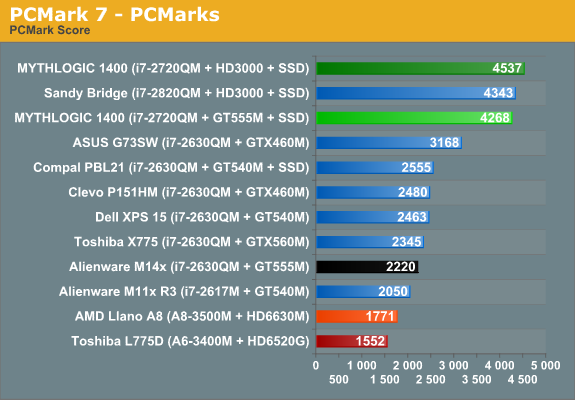
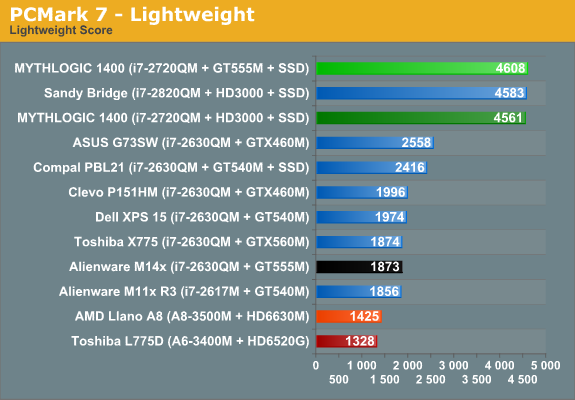

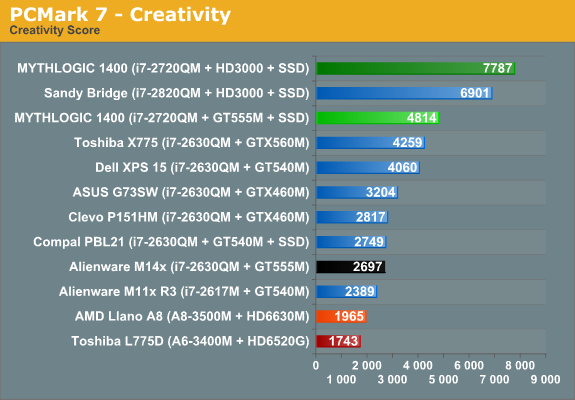

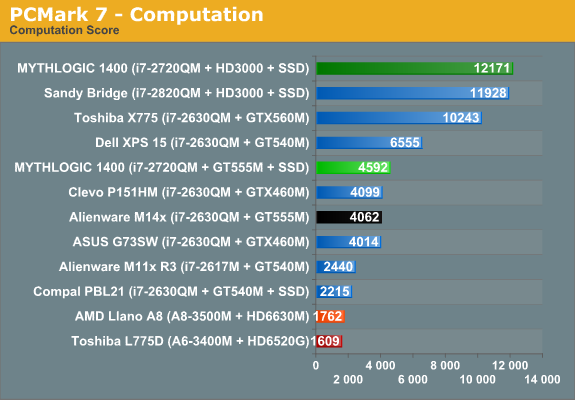
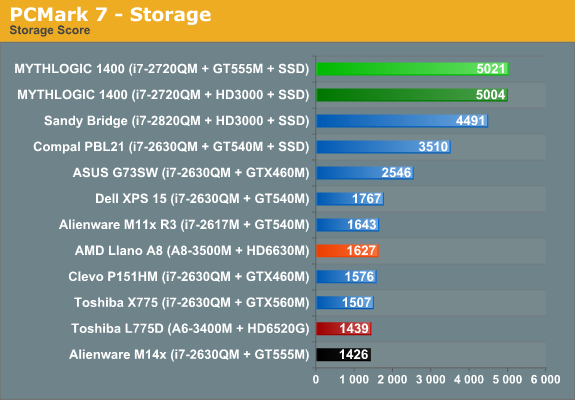
As expected, the MYTHLOGIC Pollux 1400 puts in a great showing. Most of the tests end up slightly faster running on the dGPU, but the Creativity score (which does some video transcoding) is boosted 62% running on the IGP, and the Computation test (which includes video downscaling and a high quality transcode) is 165% faster with the IGP. Those gains might seem unreasonable if you haven’t used Quick Sync; our earlier testing showed that transcoding an HD video with Quick Sync could be done over three times faster than on the CPU, and nearly twice as fast as with a GTX 460M. Throw in an SSD, and nearly every suite shows dramatically improved performance, but that’s because every suite (except for Computation) includes a storage element. As such, the results seen here are absolutely valid, provided you understand what is being tested. If you never transcode videos, the “Computation” suite doesn’t mean much, and if you’re not hitting your HDD/SSD a lot (e.g. just surfing the web), an SSD likely won’t double your pleasure, fun, or anything else. That’s why we again refer you to the PCMark 7 whitepaper.
PCMark Vantage echoes the results of PCMark 7, which is understandable if you look at the PCMark Vantage whitepaper (many of the tests are similar to PCM7 in nature, only without Quick Sync support). The remaining tests focus almost exclusively on the CPU.
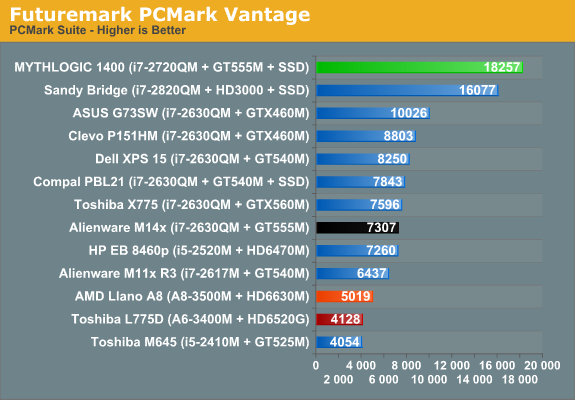
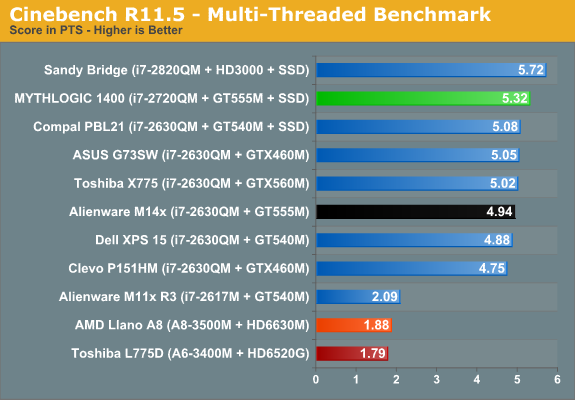
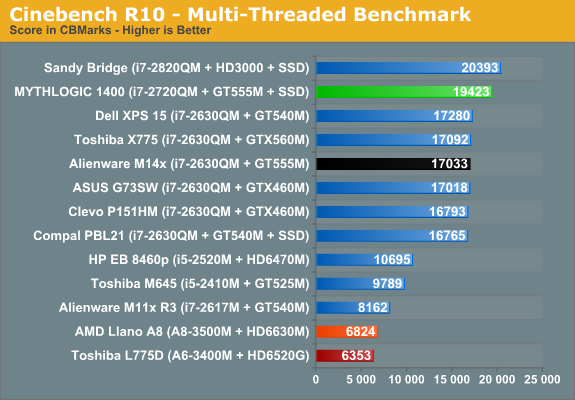
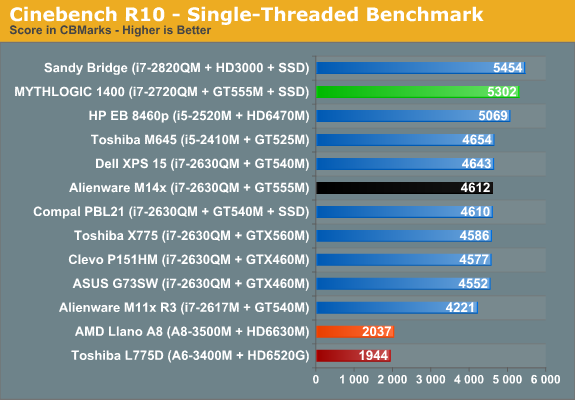
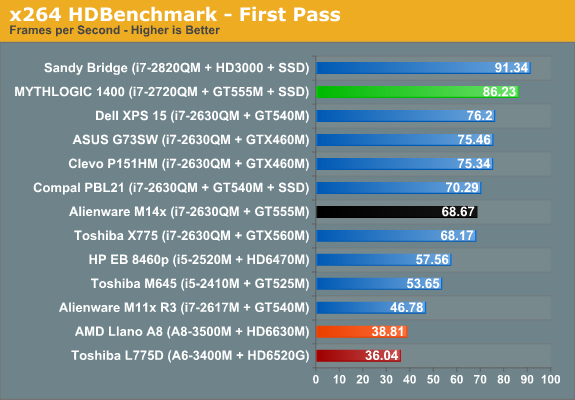

Everything falls out right where it should in our tests: the Pollux 1400 is super fast in PCMark Vantage (thanks to the combination of SSD, CPU, and GPU), and the i7-2720QM is faster than another other mobile CPU we’ve tested, with the exception of the slightly higher clocked i7-2820QM. You can also see how popular the i7-2630QM is with big OEMs; interesting to note is that for smaller companies like MYTHLOGIC, there doesn’t appear to be much of a pricing break on the 2630QM. The upgrade from the 2630QM to the 2620QM costs a scant $25, which seems like a very good deal compared to the $150 extra you’ll pay for that upgrade at Alienware.
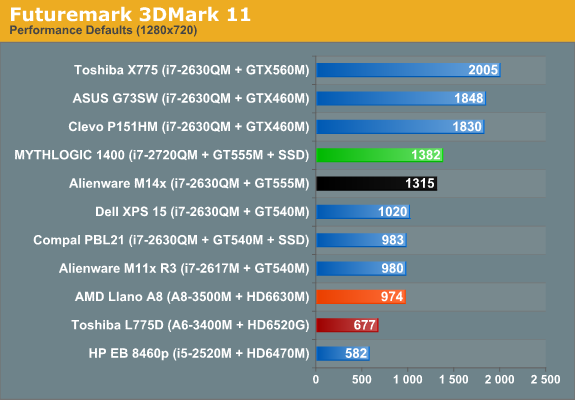
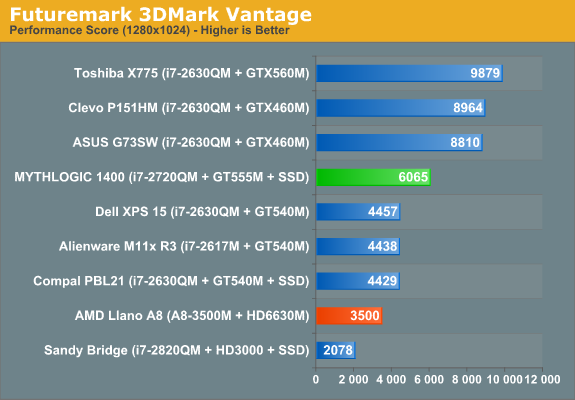
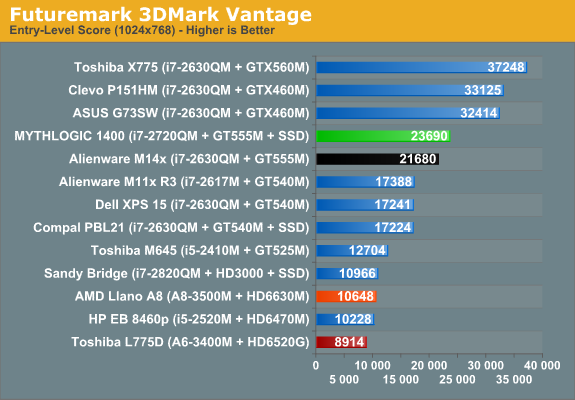
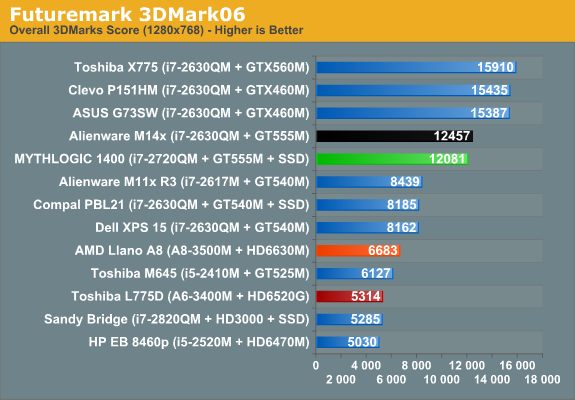
And as one final set of charts before we get to the games, here’s what the various 3DMark suites tell us. The Pollux 1400 actually bests the Alienware M14x in two of the three results where we have M14x scores, which is odd considering the 192-bit interface employed by the GT 555M in the M14x. We’ll have to see if any of that carries over into actual games, as on paper we’d expect the M14x to come out ahead for graphics benchmarks.










22 Comments
View All Comments
CAndrews - Tuesday, August 23, 2011 - link
Is a review of the W520 coming?JarredWalton - Tuesday, August 23, 2011 - link
Sadly, no. Lenovo has not sent any review samples to us for a couple years.TotalLamer - Tuesday, August 23, 2011 - link
Oh really... ? What did you guys do to piss in their Cheerios? Haha.But on another note... any chance of a review on the 3830TG you mentioned? It's a nice looking machine and seems like the only notebook that can even come close to competing with everything you can get in a Sony Vaio SA (except for the 1600x900 display) but I've heard not-so-nice things about the heat dissipation
JarredWalton - Tuesday, August 23, 2011 - link
Yes, I'm working on the review. And it really *is* a nice looking machine with no major issues so far. I haven't tried stress-testing it for heat yet, and that may be the one area where it has some problems. We'll see.TotalLamer - Tuesday, August 23, 2011 - link
Yeah... I've heard there's throttling. Lots and lots of throttling. BAD throttling.JarredWalton - Tuesday, August 23, 2011 - link
I thought I saw something stating the GPU speed was 600MHz at one point when I was messing around (instead of the normal 672MHz of the GT 540M). Considering the dimensions of the chassis, I was actually quite shocked that they have the 540M in there.hybrid2d4x4 - Tuesday, August 23, 2011 - link
I briefly had the lowest-end config with the 2310 cpu and it throttled down to 1.3GHz under Prime95 without anything stressing the GPU, so I'm pretty sure I know what result you'll get, Jarred.Still, at $600 you get a really good feature set and hardware for the money but the quality control is non-existing. Of the 3 I had, 2 had corruption in HDMI output that made it unusable and 1 had half the keyboard keys not working. Going to play the lottery some more today to try and get a working one...
rallstarz - Tuesday, August 23, 2011 - link
Thanks for the review! I am trying to decide between the W150HR and the Dell XPS 15. Since I don't much mind for limited battery life and don't mind so much the nonstandard keyboard, it seems that the Clevo gives the best bang for the performance buck. My only concern is the longevity of the laptop. Do you know if pushing the thermal specs will significantly decrease longevity? Also (and I know you touched on this) for general use/gaming, does the system hit max cpu load for an extended period of time, or is your "worst-case" scenario truly a situation that the system does not generally hit?mythlogic - Tuesday, August 23, 2011 - link
Hey, I carry around one of these for my own use. It only gets REALLY hot (and never ever really hits 100 under "normal use") when i'm gaming on it, but just sitting on my lap its never too bad, or on a desk.JarredWalton - Tuesday, August 23, 2011 - link
Playing a game for a couple hours, you can expect to hit CPU temperatures of around 90-94C, which is hot but not quite 100C.